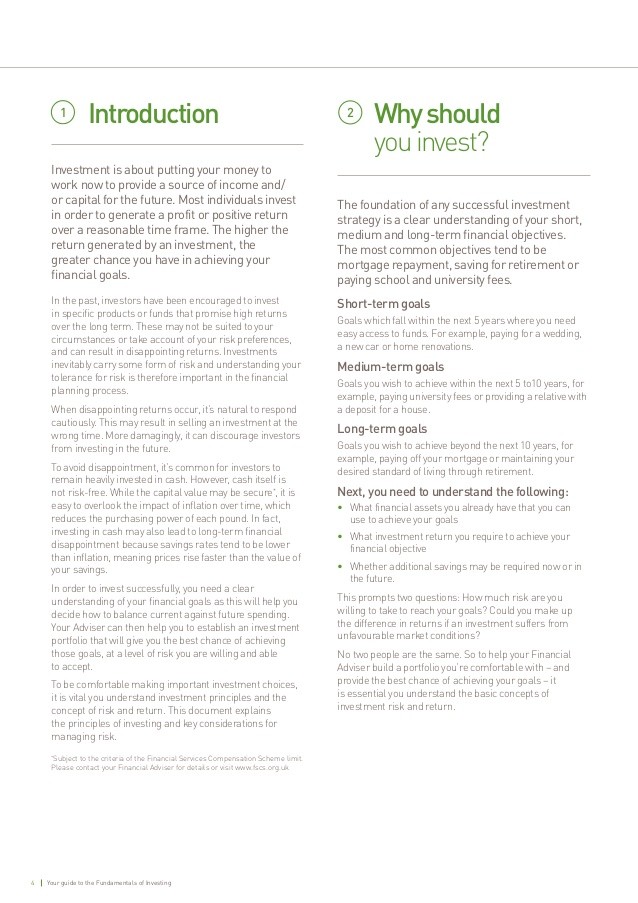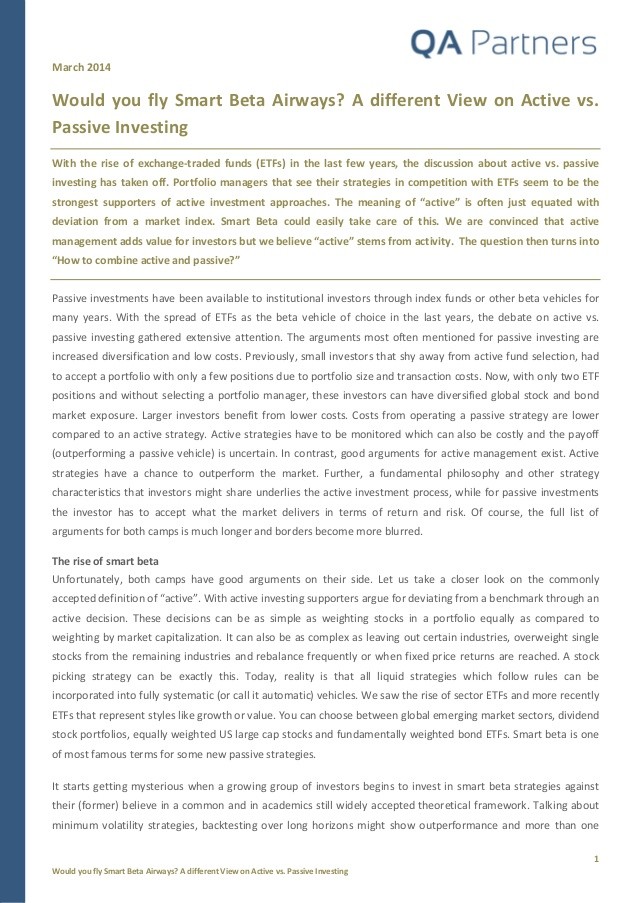Active vs Passive investing_1
Post on: 8 Апрель, 2015 No Comment

An overview
There has long been debate between supporters of active and passive investments as to which is better. We argue that there is plenty of scope for both to co-exist happily.
Passive investing, sometimes called index investing, is a strategy that tries to replicate the returns from whatever index it tracks. That may be the FTSE 100 Index or something less well known. These days there are many passive funds and Exchange Traded Funds (ETFs) available to investors.
Passive investments are popular with those who believe active management to be unreliable and expensive. Instead, the passive investor is happy to accept market returns in exchange for the peace of mind that nobody is overcharging and returns are unlikely to seriously underperform the market. Of course even passive funds have some charges so returns are virtually guaranteed to be a little lower than those of the index itself.
Active investors are not prepared to accept average market returns and want to beat the market. They know they will have to pay higher fees to do so but this is balanced by the possibility of higher returns.
Passive is usually cheaper
Active investments have an extra layer of costs to facilitate active management. There are still some active investments that are much more expensive than others but even the lower cost funds are generally more expensive than passive. For passive, keeping costs low helps avoid underperformance.
Can you pick good active funds?
The best active funds outperform the market whereas passive can, at best, virtually match the market. But how do you pick the right ones?
Of course performance depends on the skill (and many would say the luck) of the manager. Over two-thirds of active managers with a 10 year track record have failed to beat the FTSE All Share Index over 10 years (M&G, 2011). With those odds, how do you pick the right one?
It takes significant time and effort to search for the best active funds. Even with some knowledge and appropriate research tools, it is not always easy to compare.
Once you have selected your funds, you still have to put your faith in the managers. There is nothing to say that last year’s star funds will not be this year’s dogs.
Can you pick good passive funds?
You know approximately what to expect with passive investments – they are designed to follow whichever index they are based on. Although you cannot predict the market itself, you can at least say with confidence that you will get approximately the market return.
Passive can be transparent too – it’s generally no secret what’s within an index tracker since the composition of the index is known. Complications arise when you look at precisely how the index is replicated. For example some ETFs simply hold a portion of the stocks in the index (physical replication) but others try to replicate the same effect through other financial instruments (synthetic replication). The latter are obviously more complex to understand and carry different risks which the inexperienced investor may be unaware of – counterparty credit risk, for example.
Even in physical replication, if for example there are illiquid stocks in the index, the ETF manager may sample the index rather than invest in all of the assets it contains. So here you may have tracking errors as the fund does not precisely match the index.
So with passive investments there is still significant research to be done although you are arguably less likely to pick a serious underperformer than with active investments.
What happens in difficult markets?
What happens when markets fall?
When markets fall, active managers have the option to change their strategy in an attempt to minimise losses or even make gains. Passive investments will slavishly follow the market all the way to the bottom.
Smaller, high growth companies
As companies grow in size they often change in nature too. Whilst it is by no means a rule, many smaller companies have fewer protections in place for shareholders, take higher risks and grow more quickly.
Large companies tend to have more processes, transparency (leaving aside fraud or dishonesty which after all can occur in companies of any size) and reporting as well as being the subject of much more scrutiny from the outside. In conditions such as these only somebody who does considerable research will understand the various players in the market.
Imperfect markets, local knowledge
Imagine you wanted to invest in a country that looked set for huge growth but which you knew was rife with corruption and had poor accountability and transparency. Would you want a passive investment or would you prefer somebody with in-depth local knowledge to manage your investments?
In well developed markets such as the UK and the US, there is a lot of information available and high reporting standards. It’s not perfect, of course, but we at least have a good idea of what companies are worth. This means that the price you pay for shares is relatively well understood by professional investors. Under such circumstances it is naturally harder for an active manager to add value since almost everybody has access to the same market information.

Taking a strategic view
Active investment is more flexible
Active investors attempt to predict the future. They may look at the bigger picture and take a view on structural changes and shifts. The manager could get this right and make fantastic returns or, alternatively, fantastic losses. With passive, you are just along for the ride wherever it takes us.
Active investments, with the flexibility to move in and out of sectors and specific companies, can balance individual elements to manage their asset allocation strategically.
Index trackers often suffer a lack of diversification. Since they seek to replicate the index they need to hold investments in proportion to the size of companies in that index. Many indices, including the FTSE 100 are dominated by two or three sectors – and also by some very large companies. If something happens to one of these sectors, the index will suffer badly.
Active managers can employ a range of different investment styles whether that be value investing, contrarian, or seeking income. With passive, the strategy is already set.
When an index rebalances the tracker fund must copy it, regardless of the implications for individual stocks within it. In other words it can be forced to buy stocks that are overpriced and sell those whose prices are currently depressed.
Asset allocation is key
The most significant factor for a portfolio’s performance will generally be asset allocation. So what makes the biggest difference is the active management of asset allocation as opposed to the active chance selection of individual stocks or investment funds. Passive can be a useful tool to gain low cost exposure to efficient markets whilst also using active management when it is likely to add more value and potentially reduce downside risk. Overall asset allocation remains the primary decision, and avoiding picking individual stocks or funds makes it less likely that you will underperform.
In other words, a portfolio could potentially include active managed funds in difficult markets but passive in some other markets.
Remember, no single strategy is right for everybody. Whatever your eventual portfolio looks like, it should reflect your attitude to risk, your capacity to take risk and your specific financial goals.
- Active can beat the market but can also cause greater losses
- Passive more reliable but only average performance
- Passive is usually cheaper
- Active struggles to add more value to large companies in well developed markets
- Active may offer downside protection in difficult markets
Some strategies incorporate active and passive investment management into an overall asset allocation strategy.














